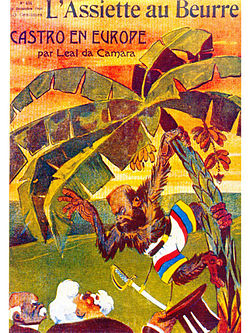You can help expand this article with text translated from the corresponding article in Spanish. (November 2023) Click for important translation instructions.
|

When the Venezuelan War of Independence started, the Spanish enlisted the Llaneros, playing on their dislike of the criollos of the independence movement. During this time, José Tomás Boves led an army of llaneros which routinely killed white Venezuelans. After several more years of war, the country achieved independence from Spain in 1821.
In Venezuela, like other South American countries, economic inequality often breaks along ethnic and racial lines. A 2013 Swedish academic study stated that Venezuela was the most racist country in the Americas, followed by the Dominican Republic. During an international summit in Caracas in March 2004, Globovisión disseminated a parody of President of Zimbabwe Robert Mugabe as a monkey, which resulted with condemnation from Algeria, Egypt, Libya, Nigeria, Western Sahara, and South Africa, which they described in a joint statement as a "crude and indecent spectacle, filled with vulgar effects, scornful comments, and endless mockery and overtures with undeniable racist content that offended African peoples and human dignity."
References
- "globalpr.org" (PDF). Archived from the original (PDF) on June 17, 2015. Retrieved 17 June 2015.
- ^ Fisher, Max (May 15, 2013). "Map shows world's 'most racist' countries". The Washington Post. Archived from the original on April 30, 2017. Retrieved April 30, 2017.
{{cite news}}: CS1 maint: bot: original URL status unknown (link) - Cannon, Barry (June 2008). "Class/Race Polarisation in Venezuela and the Electoral Success of Hugo Chávez: a break with the past or the song remains the same?". Third World Quarterly. 29 (4): 742. doi:10.1080/01436590802075020.
In March 2004, during a high-level international summit in Caracas, opposition television station Globovision parodied President Robert Mugabe of Zimbabwe as a monkey, prompting six African countries to object.
- Salas, Jesús María Herrera (March 2005). "Ethnicity and Revolution: The Political Economy of Racism in Venezuela". Latin American Perspectives. 32 (2): 84–85. doi:10.1177/0094582X04273869.